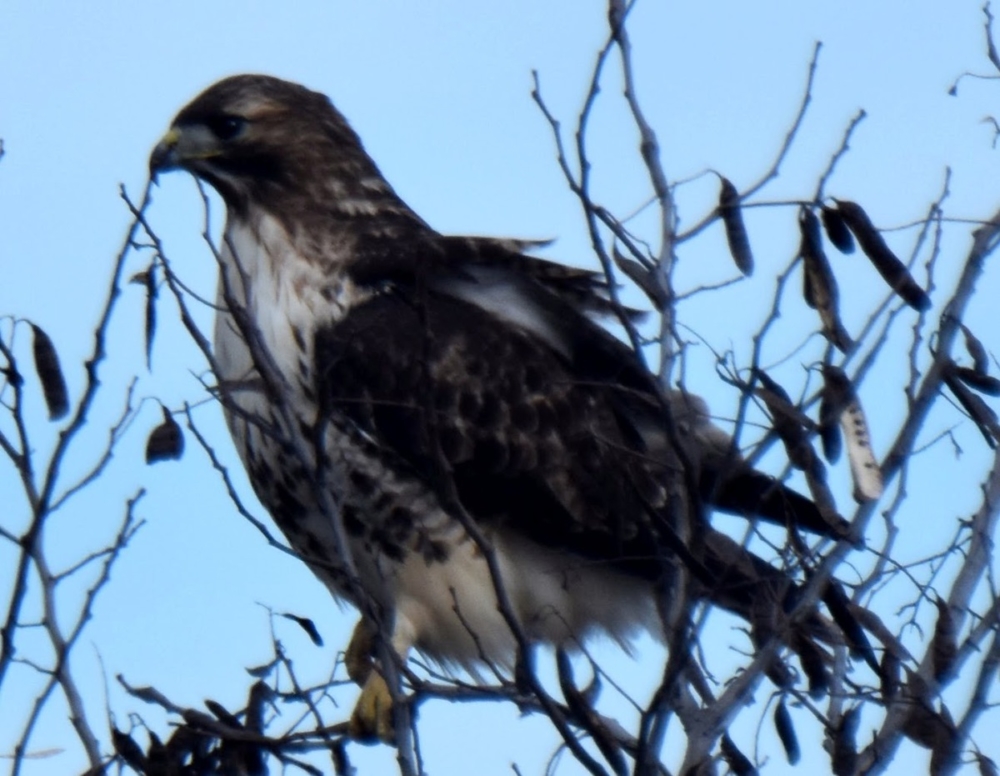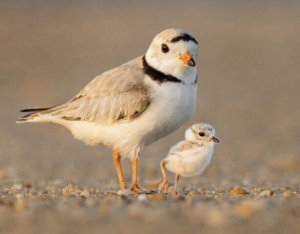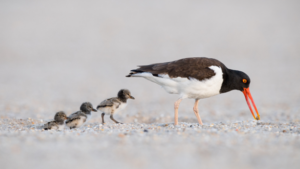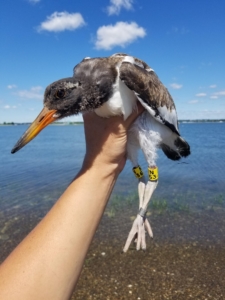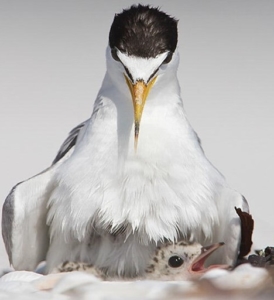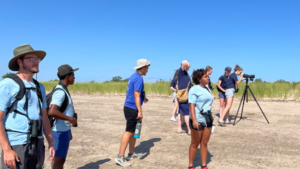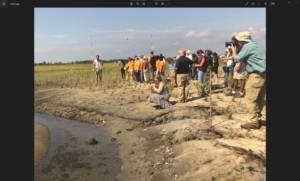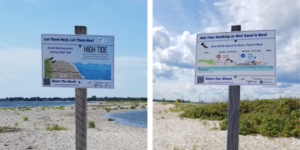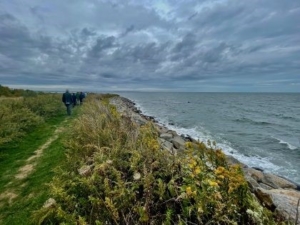Audubon Accolades from “On the Wing”
Cover Photo by Mark Brucker
2022 was a big year for Connecticut’s shorebirds and seabirds. From nest monitoring to bird banding to outreach on the beach and more, Audubon staff and volunteers worked hard to make sure the 2022 season was full of many significant conservation wins and accomplishments, including:
- A record-setting nesting season for all three of our focal species—Piping Plovers, American Oystercatchers, and Least Terns—that showed improvement from previous years.
- Continued American Oystercatcher banding efforts that have now amounted to 28% of Connecticut’s breeding population being banded.
- Completion of the first phases of the monumental Great Meadows Marsh salt marsh restoration project in Stratford, with the help of more than 150 volunteers and staff.
For threatened and endangered species, every fledged chick is a success and a sign that our hard work is worth it. All three of our focal species—Piping Plovers, American Oystercatchers, and Least Terns—had excellent nesting seasons in 2022!
In total, we monitored 66 pairs of Piping Plovers during the 2022 season. These pairs produced 97 total fledglings, adding up to a productivity of 1.51 fledglings per pair. Compared to the 2021 nesting season, this year we had more pairs, more fledged chicks, and a higher productivity—all sure signs that the population is growing!
American Oystercatchers also had a successful breeding season, with 79 confirmed breeding pairs out of a population of 200 individuals—an increase of 28% over the last decade. These pairs successfully fledged 62 chicks, amounting to a productivity of 0.78 fledglings per pair. This is higher than the 0.5 fledglings per pair recovery goal for this species, and our highest number of fledged chicks since we started this work in 2012.
The 247 pairs of Least Terns we monitored fledged 211 chicks, adding up to a productivity of 0.85 fledglings per pair. This is the highest number of fledged least terns we’ve had in years, and significantly higher than the 0.11 productivity from the 2021 nesting season.
Bands for Birds
Catching and banding fledgling American Oystercatchers helps us understand how to conserve them. Photo: Beth Amendola/Audubon
In addition to monitoring, we also continued our banding efforts with the American Oystercatcher. To date, we have banded 45 adults (making up 28% of Connecticut’s breeding population) and 17 pre-fledge chicks. The bands allow us to learn all about where birds go, and when, so we can better understand their movements and what it will take to conserve these birds.
Point of view shot of a person holding a scruffy fledgling American Oystercatcher. Around its legs are numbered yellow bands and silver bands.
This year, we got a surprise visit from two birds we had banded in 2020 and hadn’t sighted since—the first of the 17 chicks we’ve banded to be re-sighted returning to CT! You can help the American Oystercatcher banding project by reporting any sightings of banded oystercatchers to the American Oystercatcher Working Group.
Least Terns: The 247 pairs of Least Terns we monitored fledged 211 chicks, adding up to a productivity of 0.85 fledglings per pair. This is the highest number of fledged least terns we’ve had in years, and significantly higher than the 0.11 productivity from the 2021 nesting season. Thanks to the hard work of volunteers, staff, and partners, Least Terns were able to have a successful nesting season.
Front view of a Least Tern chick nestled underneath a Least Tern adult. The chick’s head pokes out from under the adult as it opens its beak. Photo: Fabiola Forns/Audubon Photography Awards
“2022 was a very successful year for CT’s beach-nesting birds thanks to hundreds of volunteers, field staff, wildlife guards, municipalities, and partners,” explains Corrie Folsom-O’Keefe, Audubon CT’s Director of Bird Conservation. “We are so thankful for to everyone for their time and efforts protecting our birds and their habitats!”
For the first time since 2020, our volunteer numbers returned to their pre-Covid numbers. As a result of holding our annual training virtually, we were able to reach a record number of 173 volunteers this season. All of their hard work added up to an amazing 1,376 volunteer hours.
With the help of our volunteers, techs, interns, and WildLife Guards, we were able to set up string fencing, install enclosures, monitor our many pairs of nesting shorebirds, and spread the word on protecting beach-nesting birds by engaging with beachgoers, boaters, and other members of the public.
An integral part of this successful season were the WildLife Guards, a group of 16 high school students and their college-age Crew Leaders who spent the summer on the beaches, monitoring shorebirds and educating and engaging beachgoers on shorebird conservation.
This year marked the first year where the WildLife Guards took part in a pair of “swap” days with one of Audubon Connecticut’s other youth conservation groups, the Junior Forest Technicians (JFT) from Bent of the River Audubon Center. In addition to learning new skills of their own, they were able to show the JFTs what its like to be a WildLife Guard, including shorebird monitoring, shorebird identification, and outreach.
Significant Salt Marsh Restoration
Partnerships with Connecticut’s environmental conservation officers and the Connecticut Dept. of Energy and Environmental Protection Boating Division also helped us expand our outreach capabilities.
Outreach on the Beach
Beaches are not the only habitat that Connecticut’s shorebirds focus on, nor are shorebirds the entire focus of our coastal conservation work. Another invaluable habitat is the salt marsh, essential habitat for birds like the declining Saltmarsh Sparrow.
Throughout the course of this year, Audubon Connecticut, in collaboration with the U.S. Fish and Wildlife Service, National Oceanic and Atmospheric Administration, the State of Connecticut, and the Town of Stratford, implemented the largest salt marsh restoration project in the state’s history at the Great Meadows Marsh in Stratford, CT.
Thanks to the hard work of our partners, Salt Marsh Stewards, crew leaders, and more than 150 volunteers, we were able to complete the first phases of the project and held a ribbon-cutting to celebrate this in August. We look forward to continuing the implementation of this restoration project and sharing progress as we do so!
Just a reminder, please be good environmental stewards and respect our environment.
Connecticut Audubon’s newest preserve: Stratford Point, a conservation centerpiece in a rich ecological region
Connecticut Audubon kicked off its 125th anniversary year by announcing the acquisition of the Stratford Point preserve, a 28-acre coastal habitat in the heart of one of the state’s most important environmental regions.
Stratford Point sits on a peninsula in Stratford, jutting into Long Island Sound and the mouth of the Housatonic River estuary. It features coastal grasslands and shrubs, salt marsh, a north-facing beach, and a coastal trail with panoramic views of the water.
Relatively isolated between the water and the adjacent neighborhood, it attracts migratory songbirds by the score and supports a growing Purple Martin colony. More than 30 species of waterfowl have been seen resting and feeding on nearby waters.
Stratford Point features a short coastal trail with panoramic views of Long Island Sound. Photo by Gilles Carter.
Its location, varied habitats, and commanding viewpoint have given birders the opportunity to see 300 species, as recorded on eBird, including rarities such as White-tailed Kite, Long-tailed Jaeger, Cory’s Shearwater, and Snowy Owl.
Stratford Point sits in an area rich with birds, fish, and other marine life, including vast oyster beds. Nearby are the 699-acre Great Meadows salt marsh in Stratford, part of the Stewart B. McKinney National Wildlife Refuge; the 840-acre Charles B. Wheeler Salt Marsh in Milford, and the Milford Point Coastal Center.
Stratford Point is also the site of important coastal resiliency research being conducted and overseen by Sacred Heart University and the Connecticut Department of Energy and Environmental Protection.
The new preserve is open to the public from 9 a.m. to 4 p.m. Monday through Friday. The sanctuary’s main building will be closed until renovations can be completed. With the acquisition, Connecticut Audubon now stewards 22 sanctuaries around the state for conservation and public enjoyment.
“Connecticut Audubon now has two locations as centerpieces of its conservation and environmental education work in the heart of one of Connecticut’s most ecologically important areas,” Connecticut Audubon Executive Director Patrick Comins said. “Our statewide vision is to conserve the natural world for birds and other wildlife, and to share the joys of nature with all. This acquisition is 100 percent in keeping with that vision.”
Stratford Point History
Stratford Point was the home of the Remington Arms Gun Club, which operated a shooting range there for decades. DuPont acquired Remington Arms in the 1940’s and operated the trap and skeet range until 1986. A large-scale clean-up of lead shot and target fragments was completed in the early 2000’s. DuPont and Remington Arms became subsidiaries of Corteva Agriscience in 2019.
Connecticut Audubon and then Audubon Connecticut, the state office of the National Audubon Society, maintained an office and conducted conservation work there in the intervening years, until Corteva donated the land to Connecticut Audubon.
Mike Liberati, the principal project director for Corteva, said, ““Connecticut Audubon Society has been a key partner in the restoration of this important coastal habitat. We are pleased with the property’s transformation, and it’s future use as a conservation and education resource.”
The land is already protected from development by a conservation easement. But by becoming its owner, Connecticut Audubon will be able ensure that its habitats are properly managed for the benefit of the region’s wildlife. Habitat work there will build on the success of ongoing coastal habitat work at the Milford Point Coastal Center and at the H. Smith Richardson Wildlife Sanctuary in Westport.
Connecticut Audubon became the owner on December 29, 2022. Board members Kathleen Van Der Aue and John Tower led the transaction team for Connecticut Audubon. Connecticut Audubon is grateful to Corteva for the donation, and to Corteva, the CT DEEP and Audubon Connecticut for its stewardship of the property over the years.

